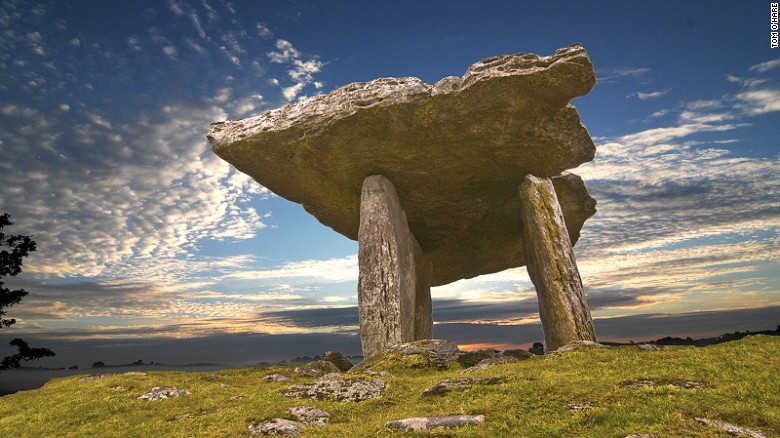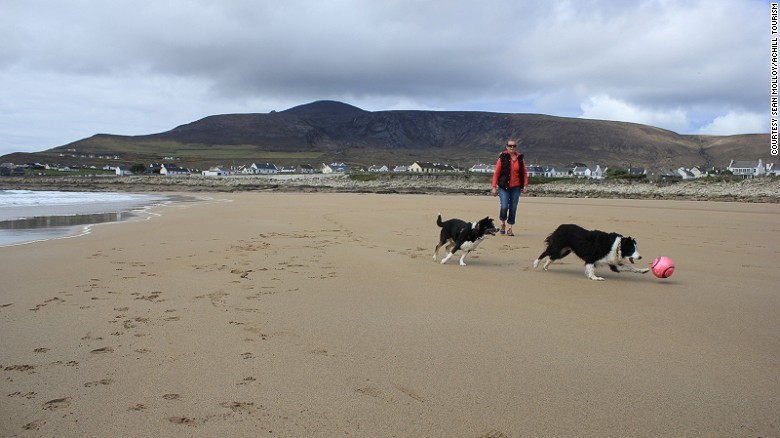A beach that was washed away by storms more than 30 years ago has reappeared off the west coast of Ireland.
The sands at Dooagh on County Mayo’s Achill Island vanished in the winter of 1984, leaving nothing but bare rock and rock pools.
But over the course of a few days in April 2017 the Atlantic returned what it had stolen, depositing thousands of tons of sand and creating a brand new 300-meter golden strand.
The storms of 1984 “completely took every last grain of sand off the beach,” Sean Molloy of Achill Tourism tells CNN.
But last month, “in the space of about eight or 10 days, these very strong winds came from the north,” he explains.
“Apparently what that does is, it blows the surface water back, because this is a south-facing beach. The sea then takes the sands underneath and brings the sands up. That’s what I’ve been told.”
Achill is Ireland’s largest island and its 57 square miles of rolling bogland, dramatic cliffs and pristine — if windswept — beaches have inspired writers including Graham Greene and Heinrich Boll.
With a population of fewer than 3,000, the main economy is tourism and the arrival of the new beach has given things an unexpected boost.
“It’s lovely,” says Roisin Lavelle, owner of Teach Cruachan B&B, which overlooks Dooagh Bay. “Mostly all you see is waves and rocks, so it has been been really lovely to see a big expanse of sand.”
It’s also coincided with a stretch of warm spring sunshine on a coastline known for its temperamental weather. “The weather is fantastic, it’s been good for the last week or so,” adds Lavelle.
Molloy estimates that Achill receives around 150,000 to 180,000 visitors a year, but the sunshine and the new beach have been bringing in the crowds. This past weekend “looked like a bank holiday weekend, so many people came.”
But while the beach is ideal for an Atlantic stroll, Molloy isn’t recommending people slip into their Speedos just yet.
“Because of the sand coming in, we don’t know how safe the beach is now because currents could be changed and it’ll take a little bit of time.”
It’s best to leave the swimming to the dolphins which regularly arrive in Dooagh Bay in large numbers.
“A lot of people come to Achill to look at the power of nature because you see the cliffs and the boglands and the beaches and mountains,” says Molloy. “This is just one very vivid example of the power of nature.”
And with the high spring tides over and the sunshine still holding, islanders are hoping their new beach is here to stay. Laughs Lavelle: “That’d be the icing on the cake, if we get the weather now!”
Click through the gallery below to see more photos of Ireland’s landscapes.
Photos:
Trinity College Long Room (Dublin) – The 65-meter “Long Room” is the main chamber of the Old Library at Trinity College Dublin. Former students who perhaps took inspiration within these walls include Oscar Wilde, Jonathan Swift, Bram Stoker and Samuel Beckett.
Hide Caption
17 of 32
Photos:
Tyrella Beach (Down) – A Irish folk song penned in the 19th century by Percy French, and later covered by Don McLean, celebrates the northeast coast “where the mountains of Mourne sweep down to the sea.”
Hide Caption
18 of 32
Photos:
The Burren (Clare) – The Burren (from the Irish word “boíreann,” meaning rocky place) is a 250-kilometer-square area in south-west Ireland. It’s a vast karst landscape of broken limestone, cliffs, caves, fossils and rock formations.
Hide Caption
19 of 32
Photos:
Dublin Docklands (Dublin) – The regenerated Dublin Docklands have seen plenty of new developments in recent years, including the construction of the Convention Centre Dublin and Samuel Beckett Bridge (pictured).
Hide Caption
20 of 32
Photos:
Ross Castle (Killarney) – Ross Castle is a 15-century tower house and keep on the edge of Lough Leane, the largest of Killarney’s three lakes.
Hide Caption
21 of 32
Photos:
Blarney Castle (Cork) – Blarney Castle — and the famous Blarney Stone inside it — are so pretty it’s no wonder people have been coming for centuries to kiss it.
Hide Caption
22 of 32
Photos:
Newgrange (Meath) – This 5,000-year-old tomb is older than the Egyptian pyramids and is an astonishing feat of Neolithic engineering. It’s aligned with the rising sun and on the winter solstice its innermost chamber is filled with light. Tickets for the annual event are only available by lottery.
Hide Caption
23 of 32
Photos:
Giant’s Causeway (Antrim) – Legend has it that these interlocking basalt columns were formed when Irish giant Finn McCool built a bridge across the Irish Sea so he could go fight a Scottish giant with whom he had beef. The scientific explanation is almost as good, though. The 40,000 pillars are the result of a volcanic eruption some 50 to 60 million years ago.
Hide Caption
24 of 32
Photos:
Hill of Tara (Meath) – The Hill of Tara is the ancient seat of the High Kings of Ireland and has been in use since the Neolithic era. Margaret Mitchell borrowed some of Tara’s resonance when she gave its name to Scarlett O’Hara’s beloved homestead in “Gone With the Wind.”
Hide Caption
25 of 32
Photos:
Glendalough (Wicklow) – The glacial valley of Glendalough is home to a sixth-century monastic settlement founded by Saint Kevin. He was an ascetic, with one particularly lurid legend claiming he drowned a woman who tried to seduce him.
Hide Caption
26 of 32
Photos:
Kinsale (Cork) – A stop on the Wild Atlantic Way — a 2,500-kilometer driving route along the west coast — Kinsale claims to be Ireland’s foodie capital. The 40th Kinsale Gourmet Festival takes place this October.
Hide Caption
27 of 32
Photos:
Dark Hedges (Antrim) – You might recognize this avenue of 18th-century beech trees from the second season of “Game of Thrones,” when Arya Stark flees King’s Landing disguised as a boy. The village of Stranocum is now a regular stop on Northern Ireland’s “Game of Thrones” location tours.
Hide Caption
28 of 32
Photos:
Lismore Castle (Waterford) – Want to stay in your own private 12th-century castle, complete with 15 bedrooms? The Irish seat of Britain’s Duke of Devonshire, Lismore Castle is available for exclusive hire — at about 50,000 euros a week.
Hide Caption
29 of 32
Photos:
Achill Island (Mayo) – Achill is the largest island off the coast of Ireland and is home to a population of fewer than 3,000 people. The land here is mostly peat bog.
Hide Caption
30 of 32
Photos:
Allihies (Cork) – The Allihies Copper Mine Trail is a walking route around the wild Beara Peninsula, with spectacular mountain and sea views.
Hide Caption
31 of 32
Photos:
Glenariff Forest Park (Antrim) – Hidden from the crowds heading to the nearby Giant’s Causeway, Glenariff Forest Park is home to the Waterfall Walkway, featuring a total of three stunning waterfalls along its path.
Hide Caption
32 of 32

Photos:
Poulnabrone Dolmen (Clare) – Poulnaborne is a Neolithic portal tomb in the Burren region, dating back to as early as 4,200 BC. It attracts around 200,000 visitors each year.

